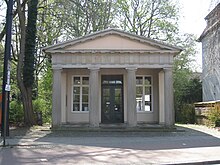Gut Kreyenhorst
Gut Kreyenhorst (also Gut Kreienhorst , formerly Gut Rosenthal or Gut Knoop ) was an upper-class property with an extensive park in the Horn-Lehe district of Bremen . The former garden house or tea house (corner of Schwachhauser Heerstraße and Horner Heerstraße ) is the last remaining structure on the property today. In addition, the streets Rosental , Deliusweg , Kreyenhorst and Am Rickmers Park in Horn-Lehe are reminiscent of the former estate.
Good Rosenthal
In the 18th century the later Gut Kreyenhorst belonged to the "three country estates of the Vahr" which remained under Bremen sovereignty in the Second Stade Comparison (1741) and belonged to the village of Horn. They were to the east of Vahrer Strasse (today Mayor-Spitta-Allee ). The property was initially owned by Dr. Dietrich Rosenkamp (1698–1780), who gave the property the name Gut Rosenthal and laid out a long avenue of oak trees that reached to the Achterdiek . In 1794, according to a map by Christian Abraham Heineken, it is referred to as "Werner Wilckens' estate in der Vahr" - a large two-winged property and an artificial island with a pavilion can be seen on the site. In 1806 the merchant and consul Arnold Delius bought the property and had the garden rebuilt. After Delius's death, the house was leased for a few years as a summer residence and used as an inn until it passed into the possession of Everhard Delius in 1828, who had Jacob Ephraim Polzin build a small classicist tea house on the northern property line , the so-called "Temple of Friendship" . The building has been a listed building since 1973.
"Schloß" Kreyenhorst
In 1869 Daniel Diederich Knoop bought the site, had the old country house demolished and between 1873 and 1875 Johann Georg Poppe built a castle-like property in the neo-renaissance style that exceeded everything in size and splendor that existed in Bremen at the time. In 1888 ownership passed to the shipping heir Wilhelm Rickmers and then to his son Willi Rickmer Rickmers . He expanded the property up to the Achterdiek to a total of 312 acres and had an English landscape garden with its own hunt laid out here, which was known as Rickmers Park . The painter Arthur Fitger , who was friends with Rickmers, built a house with a studio on a piece of land in the garden and created large wall paintings for "Schloss" Kreyenhorst - as the property was now called.
When Rickmers died in 1891 and Vahrer Strasse was rebuilt in 1894, the first property sales along the street were made. Kreyenhorst lay fallow for 20 years, the castle fell into disrepair and the park overgrown. In 1911 the Bremen state bought the property after lengthy negotiations and had Kreyenhorst Castle demolished in the 1920s. As a result, the city made the site a public facility with a country house district. In 1936, when the Reichsautobahn (now Federal Highway 27 ) was built, a large part of the property was cut off. Willi Rickmer Rickmers youngest brother, the Rittmeister Johann Rickmers , who was killed while participating in the 1923 Hitler coup in Munich, was dedicated to a memorial stone in the park after the National Socialist seizure of power . From 1933 the rhododendron park was laid out on parts of the former Rickmers Park and the adjacent Allmers Park .
Individual evidence
- ^ Herbert Barre: 800 years of Horn-Lehe . Ed .: Parish of Horn. Bremen 1985, p. 58 .
- ^ Monument database of the LfD
- ^ Rickmers Park. In: Chronicle Horn-Lehe. Retrieved January 9, 2010 .
- ↑ Gustav Brandes: From the gardens of an old Hanseatic city . A. Geist Verlag, Bremen 1939.
literature
- Herbert Barre: 800 years of Horn-Lehe . Published by the parish of Horn, Bremen 1985.
- Michael Koppel: Horn-Lehe-Lexikon . Edition Temmen , Bremen 2012, ISBN 978-3-8378-1029-5 .
- Rudolf Stein : Classicism and Romanticism in the architecture of Bremen . Hauschild Verlag , Bremen 1964
Coordinates: 53 ° 5 ′ 28 " N , 8 ° 52 ′ 18.9" E

